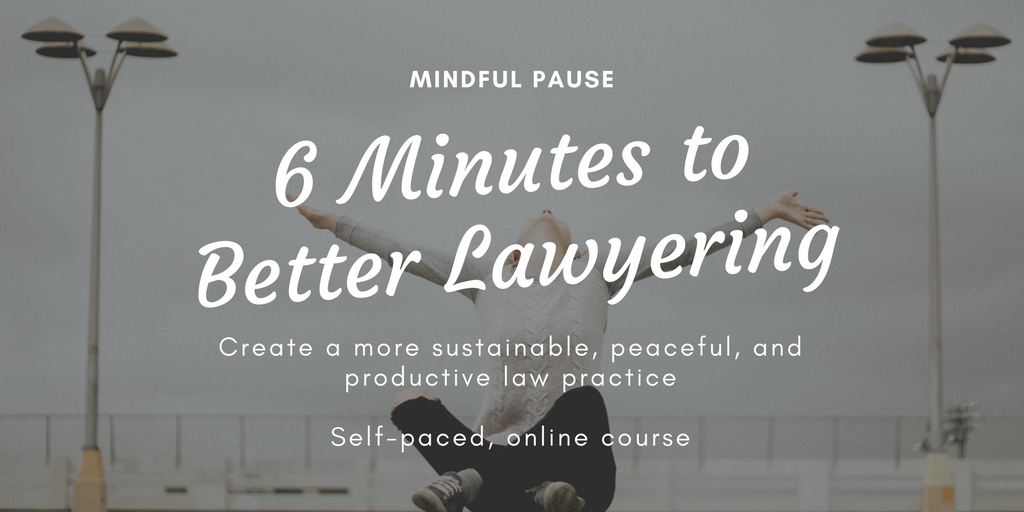Last year, my co-author, Karen Gifford and I had an opportunity to partner with the National Association of Women Lawyers (NAWL) and Seyfarth Shaw LLP to offer an 8-week mindfulness and meditation program. We used our book, The Anxious Lawyer, which conveniently has an 8-week program in it as the guide. As part of the program, participants were asked to take part in a study to measure the impact of mindfulness and meditation for lawyers.
The format of the 8-week program was simple. We offered three 1-hour CLE qualified webinars and each participant received a weekly email containing a short guided meditation (6 or 12 minutes). Participants were invited to attend all three webinars and meditate daily.

Professor Paul Minda from University of Western Ontario and his graduate students ran the study and I’m happy to report the findings.
- Job effectiveness: increased by 6.15%
- Depression: decreased by 28.84%
- Anxiety: decreased by 30.29%
- Stress: decreased by 32.45%.
Professor Minda used the same measurements as the study sponsored by the American Bar Association (Krill, Johnson, & Albert, 2016). In that study, the results indicated that lawyers suffered from high rates of stress, anxiety, depression, and substance/alcohol. Minda and his team wanted to know if lawyers would benefit from mindfulness and meditation.
Similar to the Krill study, this study ”observed fairly high levels of depression, anxiety, and stress” in its sample. Consistent to non-lawyer population, lawyers benefitted from mindfulness and meditation practices. Lawyers reported decrease in stress, anxiety, depression and also increase in workplace effectiveness. (Proving that lawyers aren’t such special snowflakes after all.)
Here are the findings:
[T]hese items were included for qualitative insight into how participants perceived their own ability to perform on the job… In order to obtain an overall idea of workplace effectiveness, we averaged across the items to obtain a mean job effectiveness score for each participant. Pre- and posttest effectiveness scores were compared with a paired-samples t-test using α = .05. This analysis revealed a significant increase in effectiveness scores between the pretest and posttest phases, or an increase of 6.15%.
Just pause and consider for a moment the impact of increasing your workplace effectiveness by 6% would have. Assuming 40 hour workweek, a 6% increase would be 2.4 hours. Suppose you have a law firm with 500 attorneys. That would be an increase of 1,200 hours.
This benefit was gained by practicing meditation approximately 9 minutes per day. The study notes, “on average, participants meditated 57.98 minutes per week (min = 0, max = 315, SD = 63.89).”
Other significant benefits of meditation and mindfulness practices were also noted, including:
Depression scores decreased by 28.84%, anxiety scores decreased by 30.29%, and stress scores decreased by 32.45%.
Minda compared the pre-study and post-study measurements for depression, anxiety and stress then compared it to the Krill (ABA) study. Results are as follows:
| Table 5. Comparison of the data from Krill et al. (2016) with the present pretest and posttest DASS-21 data. | |||||||||
| Diagnostic Category | Depression | Anxiety | Stress | ||||||
| Krill et al | Pre | Post | Krill et al | Pre | Post | Krill et al | Pre | Post | |
| Normal | 71.7 | 50.0 | 65.2 | 80.7 | 41.3 | 65.2 | 77.3 | 32.6 | 67.4 |
| Mild | 9.5 | 17.4 | 13.0 | 8.6 | 8.7 | 15.2 | 8.8 | 13.0 | 8.7 |
| Moderate | 10.4 | 15.2 | 13.0 | 5.0 | 32.6 | 15.2 | 8.2 | 19.6 | 10.9 |
| Severe | 4.0 | 6.5 | 2.2 | 2.5 | 10.9 | 2.2 | 4.4 | 30.4 | 10.9 |
| Extremely Severe | 4.4 | 10.9 | 6.5 | 3.1 | 6.5 | 2.2 | 1.3 | 4.3 | 2.2 |
| Note: Values in each cell represent the percentage of the total sample in each diagnostic category
|
|||||||||
As the data indicates, the participants of this study reported experiencing higher levels of depression, stress and anxiety than Krill’s study. There are several possible explanation for this “sample might have shown more severe scores relative to the participants in Krill et al.”
Theirs [Krill’s study] was a very large sample (12,825) which implies that their observed scores will be closer to a true mean. Second, our sample was collected from a subset of lawyers who belonged to the National Association of Women Lawyers. Krill et al. found that women lawyers scored higher than men on the Anxiety and Stress (though not Depression) subscales of the DASS-21. As such, our sample of primarily female lawyers may have had elevated levels of anxiety and stress. Third, our study was conducted during the 2016 US presidential election, which was noted to be a stressful time for many Americans (American Psychological Association, 2016).
There are certainly limitations to this study, like any study based on self-reporting, however, a few things are clear.
Web-based mindfulness and meditation programs can and does have a positive impact on lawyers sense of well-being. As is discussed in the study, the “gold standard” for learning mindfulness is a program called Mindfulness Based Stress Reduction (MBSR) founded by Dr. Jon Kabat-Zinn from University of Massachusetts Medical School. This is an 8-week in-person class with each session lasting for 2.5 hours, plus a daily recommended meditation practice of 45 minutes.
I took this class three times and completed the teacher training practicum. Certainly, for those lawyers that has the time to be able to attend the in-person class, that would be preferred to an online webinar. However, this study clearly demonstrates that an online class is an effective way to teach mindfulness to lawyers and to see the benefits. As noted in the study, “The use of a customized online platform, therefore, allowed for the development of a program that was context-specific and convenient yet, nevertheless, effective.”
In total, the NAWL program had 968 lawyer participants. 46 of those lawyers participated in the study. CLE credits were provided by Seyfarth Shaw LLP, which attributed to the high number of sign-ups. The program approximately costs $100 per attorney (including copy of The Anxious Lawyer book).
There are two limitations to the study, as is discussed in the paper.
First, is the lack of control group. Since we recruited participants for the NAWL online 8-week program, there was no way to have a control group that would not participate in the study during that 8-week program. Second is potential self-selection bias. As Minda discusses in the paper, “all of our participants enrolled in this study because they wanted to learn about the possible benefits of mindfulness meditation. This raises the possibility of expectancy effects whereby, because they expressed a desire to learn about mindfulness, changes may have occurred simply because participants expected to see improvements in these key areas.”


